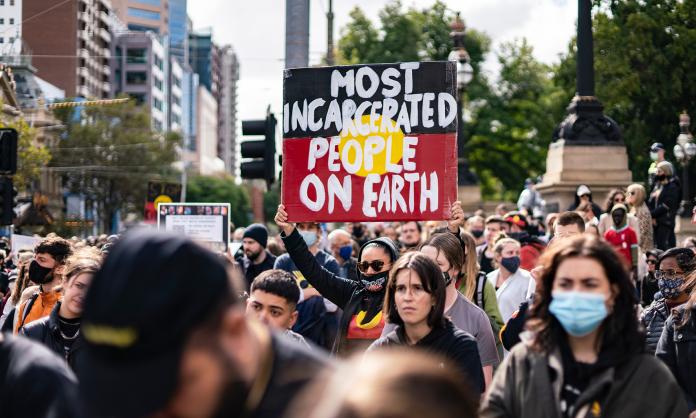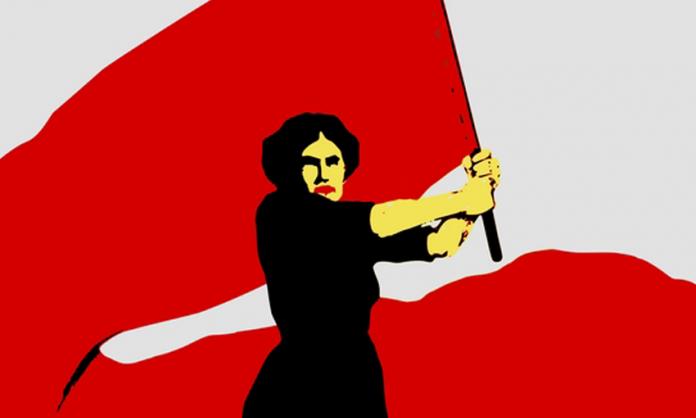More than 10 million people are incarcerated in prisons around the world. In Australia, the incarceration rate is the highest it has been in a century. According to a recent Productivity Commission research paper, the number of prisoners per 100,000 adults has more than doubled since the mid-1980s and increased by 40 per cent since the beginning of the century.
Despite the soaring rate of imprisonment, the offending rate has fallen by 18 percent over the last decade. In other words, police are laying charges against fewer alleged criminals, yet more people are being imprisoned.
The Northern Territory and Western Australia lead all other jurisdictions in locking people up. The Territory’s imprisonment rate—971 prisoners per 100,000 adults, according to Australian Bureau of Statistics data—is more than four times the national average. Western Australia’s imprisonment rate—326 prisoners per 100,000 adults—is 50 percent higher than the national average.
First Nations people are sixteen times more likely to be locked up than their non-Indigenous counterparts. Incarceration rates for First Nations youth are even higher: most youth in detention are Indigenous.
Imprisonment as a form of punishment is widely considered normal in our society. And we are told that, without prisons and police, social cohesion would break down. Yet prisons are, in historical terms, a recent innovation. They were pioneered in Britain and North America just two centuries ago.
Prior to the arrival of the “modern” penitentiary, jails were not used to detain prisoners as a means of punishment, but rather used as holding cells before corporal or capital punishment was inflicted. Such punishment was a public spectacle, typically held in front of a jeering crowd in a town square.
Feudal-era punishments were brutal indeed. Michel Foucault, in his study Discipline and Punish: The Birth of the Prison, describes in graphic detail a 1757 public execution in Paris. The condemned man had his flesh burned from his limbs with red-hot pincers. Molten lead and boiling oil were poured into his wounds. He was then drawn and quartered.
English common law offered similarly grotesque punishments. A conviction of sodomy resulted in the accused being buried alive, while heretics (those who challenged established religious dogma) were burned alive. The 1790 Treason Act reformed the punishment of women convicted of treason: they could thenceforth be hanged instead of burned alive.
The penitentiary movement, led by Protestant reformers during the rise of capitalism, advocated the detention of prisoners as a more humane alternative to the macabre corporal and capital punishments of the day. Their rationale was that prisoners should be given time to repent for their sins.
Imprisonment served to discipline a newly constituted working class concentrated in urban factories, the powerhouses of the industrial revolution. In the preceding centuries, peasants were kicked off their traditional lands by feudal lords and freeholders, forcing them to migrate to towns and cities to find work.
The new regime of factory labour was radically different from the timeless existence that peasants had experienced on feudal estates. Factory owners tried to cultivate what prison abolitionist Angela Davis described, in her book Are prisons obsolete?, as “an army of self-disciplined individuals capable of performing the requisite industrial labour for a developing capitalist system”.
Incarceration coincided with notions of rights (for men) and their deprivation as a form of punishment. Just as labour was measured in time, so too was incarceration.
Utilitarian philosopher Jeremy Bentham argued that to internalise productive labour habits, criminals needed to be constantly supervised. He developed a prison model, known as the panopticon, to do just that. Through architectural design, prisoners would be unable to see each other, but could always be seen by the prison guard.
The Penitentiary Act of 1799 ushered in the modern prison, incorporating the philosophy of the Protestant church and Bentham’s concept of universal surveillance. The first English penitentiary opened in Millbank in 1816.
Across the Atlantic, both Bentham’s panopticon and Protestant notions of penitence and reform took hold in the industrial north of the United States. In 1790, Pennsylvania’s Walnut Street Jail was converted into a convict institution, where prison sentences were both punishment and supposedly a means of rehabilitation. A larger Eastern State Penitentiary opened in Cherry Hill in the 1820s. Under the Pennsylvania model, total isolation, silence and solitude were the order of the day.
While such solitude was believed to enrich the soul, it more often turned prisoners mad. Charles Dickens wrote after an 1842 visit to Eastern State Penitentiary that “those who devised this system of Prison Discipline ... do not know what it is that they are doing”.
“I believe that very few men are capable of estimating the immense amount of torture and agony that this dreadful punishment, prolonged for years, inflicts upon the sufferers”, Dickens wrote. “I am only the more convinced that there is a depth of terrible endurance in it which none but the sufferers themselves can fathom, and which no man has a right to inflict upon his fellow-creature.”
In the United States, two economic regimes coexisted at this time. In the South, slaves trafficked from Africa worked the plantations. Slave owners had no use for prisons; imprisonment of their slaves would deprive them of labourers they “owned”.
The 1865 abolition of slavery, following the Confederacy’s defeat in the US Civil War, ushered in a new regime. White convicts in southern penitentiaries were soon replaced by Blacks, who were farmed out to employers in chain gangs. The Thirteenth Amendment, abolishing slavery, specifically excepted penal servitude, which was already common practice across the free states.
In the South, Black Codes legalised a system of racial incarceration, replicating many features of slavery. However, the treatment of leased convicts was often far worse than that of chattel slaves. Whereas slave owners had an incentive to keep slaves alive, convict labour was far more expendable.
While the convict lease system was formally abolished in southern states by the late 1920s, similar forms of convict exploitation have endured and re-emerged in the era of mass incarceration.
Alabama reintroduced chain gangs in 1995, and Florida followed in 2013. Other states lease convicts to private corporations, albeit without the chains.
Prisoners offer employers labour at a bargain price. Private prison corporations, such as CoreCivic and G4S, sell prison labour to major corporations such as Chevron, Bank of America, AT&T and IBM.
Prisoners receive as a little as US$20 per week to work in call centres, slaughterhouses and clothing factories. Moreover, they are typically a compliant and malleable workforce that can be recruited or dispensed with in accordance with the ebb and flow of economic demand.
In a 2003 Monthly Review article, “Capitalism and Incarceration Revisited”, Richard Vogel charted US federal and state incarceration rates over the twentieth century. While US incarceration averaged 106 prisoners per 100,000 adults between 1925 and 1975, since 1975 the rate has soared. Today it stands at 639 per 100,000—a more than sixfold increase on the 1925-1975 average.
Prior to 1975, incarceration peaked during the Great Depression, when up to a quarter of the US workforce was unemployed. Incarceration dropped dramatically during World War Two, and to a lesser extent during the Korean and Vietnam wars, when an army of unemployed was conscripted and enticed to fight and die in defence of US imperial conquests abroad.
During World War Two, prison authority Thorsten Sellin presciently predicted a dramatic rise in America’s prison population, telling a convention of the American Prison Association, “When the army is demobilised, if accompanied by considerable economic dislocation, our prisons will be full again”.
However, in the postwar boom years (1945-73) there was a relatively stable prison population. This changed dramatically following the 1975 demobilisation of US troops returning from the Vietnam War.
The mid-1970s were a period of global economic crisis not seen since the Great Depression. In the ghettos of American cities, life became increasingly difficult for the industrial working class, and Blacks in particular, as factories shut their doors.
In 1980, the election of the Reagan administration ushered in a new era of class warfare. Since then, prisons have held a special place for disciplining the American working class.
The Black Lives Matter movement has prompted a revival of calls for both the reform and abolition of prisons (and police) in the US. Amid a wave of global protests following the 2020 police murder of George Floyd, rallies took place across Australia demanding an end to Aboriginal deaths in custody and the appallingly high level of Indigenous incarceration.
Since the 1991 Royal Commission into Aboriginal Deaths in Custody, nearly 500 First Nations people have died in Australian prisons and police custody. Their deaths have coincided with the blatant refusal of state and federal governments to implement the royal commission’s 339 recommendations.
Following its 2017 election, the Western Australian state Labor government pledged a one-quarter reduction in Aboriginal custody by 2028. Yet, five years later, the state’s Aboriginal incarceration rate remains stubbornly high. Aboriginal people make up 40 percent of the state’s prisoners, though only 4 percent of the state’s population.
Over the last twelve months, the number of Australian prisoners on remand has increased by 16 percent, while the number of sentenced prisoners has decreased by 1 percent, according to the Bureau of Statistics. Some of this increase is no doubt due to delays in court hearings due to the COVID-19 pandemic.
The dramatic increase in the prison population over recent decades, and stubbornly high rates of Indigenous incarceration, have fuelled calls for alternatives to incarceration. Advocates for such alternatives point to the exorbitant price of maintaining the existing system. In 2019-20, state and territory governments spent more than $5 billion keeping prisoners behind bars.
The Productivity Commission’s “Australia’s prison dilemma” research paper argues that “a one percent shift in the number of people from prison to community corrections would save taxpayers approximately $45 million per year nationwide”.
Such calls have found an echo in the propaganda of private prison corporations, which are responsible for managing the incarceration of one in five Australian prisoners.
For example, global private prison operator G4S advertises “electronic monitoring” and “rehabilitation and re-integration programs” on its website, claiming that the company is “committed to reducing reoffending through the provision of decent, respectful and positive environments that actively encourage rehabilitation”.
In truth, prison corporations are parasites that see opportunities to make profits across the supply chain of the capitalist state’s “criminal justice” system. Much of the “reform” agenda is driven by capitalist states trying both to reduce spending and to provide profit-making opportunities for security companies.
GPS-enabled ankle bracelets, facial recognition software and other surveillance tools may well replace prison cell cages and prison screws as the state’s preferred method of social control, but they remain tools of state repression nonetheless. More likely, they will extend, not reduce, the net of state surveillance.
If we are to upend this Orwellian nightmare, we must recognise that prison abolition will not be achieved by piecemeal reforms that shuffle prisoners from prisons to community detention. As US death-row inmate Mumia Abu-Jamal observes, “You cannot decarcerate by using the tools of incarceration”.
Instead, we must upend the system that created prisons—capitalism—and replace it with socialism. In a socialist future, it won’t be working-class people who are policed, but rather our former rulers.










